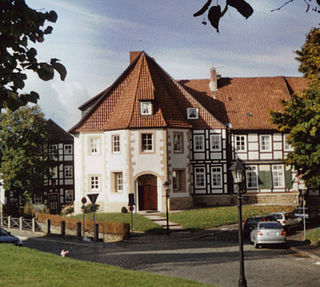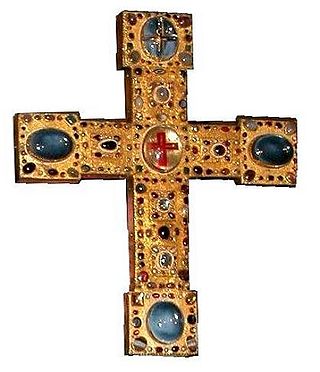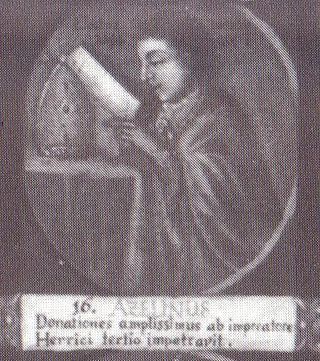
The Church of St. Michael is an early-Romanesque church located in Hildesheim, Germany. It has been on the UNESCO World Cultural Heritage list since 1985 due to the before mentioned early-Romanesque architecture and art found within such as the Tree of Jesse and the now relocated Bernward Doors.

Hildesheim Cathedral, officially the Cathedral of the Assumption of Mary or simply St. Mary's Cathedral, is a medieval Roman Catholic cathedral in the city centre of Hildesheim in Lower Saxony, Germany, that serves as the seat of the Diocese of Hildesheim. The cathedral has been on the UNESCO World Cultural Heritage list since 1985, together with the nearby St. Michael's Church because of its unique art and outstanding Romanesque architecture.

Bernward was the thirteenth Bishop of Hildesheim from 993 until his death in 1022.

St Peter's Cathedral is a Roman Catholic church and former cathedral in Worms, southern Germany.

The Prince-Bishopric of Hildesheim was an ecclesiastical principality of the Holy Roman Empire from the Middle Ages until its dissolution in 1803. The Prince-Bishopric must not be confused with the Diocese of Hildesheim, which was larger and over which the prince-bishop exercised only the spiritual authority of an ordinary bishop.
Hezilo of Hildesheim, also known as Hezelo, Hettilo or Ethilo, was Bishop of Hildesheim from 1054 to 1079.
St. Bernward's Church is a Catholic church in the city of Hildesheim in Lower Saxony, Germany. The name refers to the bishop Bernward of Hildesheim (960-1022) who was canonized by Pope Celestine III.

St. Nicholas' Chapel is a former Roman Catholic parish church in the city of Hildesheim in Lower Saxony, Germany. It is dedicated to Saint Nicholas and is located in the southern part of the old city centre, opposite St. Godehard.

A wheel chandelier is a lighting installment, in the form of a chandelier hanging from the ceiling in the form of a spoked wheel. The oldest and most important examples derive from the Romanesque period.

The Barbarossa Chandelier was made on the order of Emperor Frederick I, nicknamed Barbarossa, and his wife Beatrice sometime between 1165 and 1170 and was installed under the cupola of the Palatine Chapel in Aachen Cathedral. The chandelier was a donation in honour of Mary, Mother of God, the patroness of Aachen Cathedral and simultaneously represented a tribute to the builder of the cathedral, Charlemagne.

The term Cross of Bernward principally refers to two Ottonian crosses in the cathedral museum in Hildesheim:

The Azelin chandelier 1018 A.D is a Romanesque wheel chandelier, made in the 11th century for the Hildesheim Cathedral in Hildesheim, Germany, a UNESCO World Cultural Heritage site since 1985. It is the oldest of four extant wheel chandeliers from that period, along with the Hezilo chandelier, also in Hildesheim, the Barbarossa chandelier in the Aachen Cathedral, and the Hartwig chandelier in the Abbey of Comburg. It was believed to be donated by Bishop Azelin, however his predecessor Thietmar is more likely to be the patron. Therefore, the chandelier is also called the Thietmar chandelier (Thietmarleuchter).

The Bernward Doors are the two leaves of a pair of Ottonian or Romanesque bronze doors, made c. 1015 for Hildesheim Cathedral in Germany. They were commissioned by Bishop Bernward of Hildesheim (938–1022). The doors show relief images from the Bible, scenes from the Book of Genesis on the left door and from the life of Jesus on the right door. They are considered a masterpiece of Ottonian art, and feature the oldest known monumental image cycle in German sculpture, and also the oldest cycle of images cast in metal in Germany.

The Bernward Column also known as the Christ Column is a bronze column, made c. 1020 for St. Michael's Church in Hildesheim, Germany, and regarded as a masterpiece of Ottonian art. It was commissioned by Bernward, the thirteenth bishop of Hildesheim in 1020, and made at the same time. It depicts images from the life of Jesus, arranged in a helix similar to Trajan's Column: it was originally topped with a cross or crucifix. During the 19th century, it was moved to a courtyard and later to Hildesheim Cathedral. During the restoration of the cathedral from 2010 to 2014, it was moved back to its original location in St. Michael's, but was returned to the Cathedral in August 2014.

St. Godehard is a church in Hildesheim, Germany, formerly the church of a Benedictine abbey. It remained almost unaltered through the centuries and was not damaged much in World War II. It is one of the most important examples of Romanesque architecture in Germany.

The Bronze baptismal font in the Hildesheim Cathedral is a late Romanesque baptismal font which was probably made in Hildesheim in the first third of the thirteenth century. It is noted for its pictorial decoration which is of the highest quality and for its perfect proportions and is considered among the most outstanding works of its type. For centuries the baptismal font stood in the western part of the nave, until it was moved to the last of the northern side-chapels in 1653. During the ongoing renovations of the cathedral (2010–2014) it is being displayed in the Bode Museum in Berlin. After the completion of the renovation work, it will be placed in the centre of the nave under the Hezilo chandelier.

Azelin was Bishop of Hildesheim from 1044 until 1054.

The Hildesheim Cathedral Museum is the treasury and diocesan museum of Hildesheim, which illustrates over a thousand years of art and church history in Lower Saxony. It is located in historic rooms off the southern transept of the Hildesheim Cathedral. During the cathedral renovations of 2010, the nearby church of St Antonius and part of the cathedral cloisters were converted into display rooms for the museum.

The Great Gandersheim Conflict was a conflict between the Archbishops of Mainz and the Bishops of Hildesheim concerning the jurisdiction over Gandersheim Abbey. It lasted from 987 to 1030, during the reign of the Ottonian emperors Otto III and Henry II as well as of their Salian successor Conrad II.

Hildesheim Charterhouse is a former Carthusian monastery or charterhouse in Hildesheim in Lower Saxony, Germany.



















